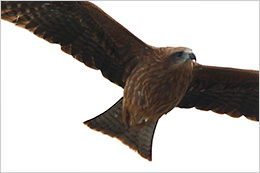In this article, a professional wildlife photographer will impart to you techniques to capture dynamic close-up shots of birds soaring in the sky using the EOS 7D Mark II. (Reported by: Gaku Tozuka)

Pages: 1 2
[Case 2] + high-speed continuous shooting is effective for close-up shots of birds
In photographing flying birds, you can classify flight patterns into two types—where the subject is flying straight toward you, and where it is flying parallel to you. When capturing a bird that is flying parallel to you using the EOS 7D Mark II, focus may sometimes end up being established on objects in the background, such as the mountains. On the other hand, if the subject is flying toward you in a sky with no obstructing objects, that is when the AF function of the camera is able to demonstrate its strength. In a scene like this, AF area selection modes that make use of multiple AF points such as Zone AF, Large Zone AF or 65-point automatic selection AF come in particularly handy.
While all of these settings allow the AF performance of the EOS 7D Mark II to be fully utilised, take note that Single-point AF (Spot AF) does not function in [Case 5] and [Case 6], which make use of multiple AF points based on the AI Servo AF characteristics. For the scene below, I selected [Case 2] with it customised to the highest sensitivity level so that focus can be maintained precisely on the face of the subject. To capture a close-up shot of its face, what I did was to simply track the movement of the bird to prevent it from moving out of the composition, and then wait for the subject to fly toward the camera.

Level of Difficulty: Medium

Lens: Super Telephoto

Light: Direct Light

Shutter Speed: Fast

Aperture: Open
EOS 7D Mark II/ FL: 700mm (equivalent to 1,120mm in 35mm format)/ EF500mm f/4L IS II USM + EXTENDER EF1.4×III/ Manual (f/8, 1/1,600 sec)/ ISO 800/ WB: Auto
I aimed at a black kite that was flying toward me. The EOS 7D Mark II performs extremely well in capturing birds soaring in the sky; you can produce successful shots most of the time regardless of which setting you choose. What you need to do is to simply combine AI Servo AF with high-speed continuous shooting to track the subject.
AF points used for focusing

What is most important is to position the face close to the centre AF point. For an AF area selection mode that makes use of a plane for focusing, you can compose a stable shot if the subject is located at the centre.
Settings
AF operation: AI Servo AF
Drive mode: High-speed continuous
AF area selection mode: Large Zone AF
AF Config. Tool: Case 2
The relative speed of the bird becomes faster as it moves closer to the camera, so trying to maintain the subject within the composition would be a challenging task. However, with the AI Servo AF + iTR AF + Large Zone AF + customised [Case 2] settings, what used to be impossible can now be done.
Taking continuous shots while looking through the viewfinder
1

2

3

4

5

To capture a bird that is flying toward the camera, it would be too late if you press the shutter button when the subject is already right in front of you. Although AF accuracy is enhanced on the EOS 7D Mark II, it still has its limitations if the subject is too close. Allow the subject to enter the composition and establish the focus while it is at a slightly distant position from the camera. Next, start high-speed continuous shooting when the subject is at a distance where it looks sufficiently large. Look through the viewfinder carefully to make sure that the bird does not move out of the composition so you do not end up getting a large number of headless shots.
Settings related to the AI Servo AF characteristics

I tweaked the [Case 2] AI Servo AF characteristics to "ultra-sensitive" by customising Tracking sensitivity, Accel./decel. tracking, and AF pt auto switching to [+2]. Doing so allows me to capture the dynamic movements of the bird, such as the moment it soars into the sky and when it is battling in the sky. This setting is suitable for AF area selection modes that make use of multiple AF points.

Born in 1966 in Aichi, Tozuka developed an interest in photography when he was in the third year of high school, and started to capture natural landscapes as well as wildlife animals. At the age of 20, he became absorbed in photographing wild birds after accidentally capturing a woodpecker in his photo. He has released a large number of works in media such as magazines, bulletins, books, calendars and TV commercials.

A monthly magazine that believes that enjoyment of photography will increase the more one learns about camera functions. It delivers news on the latest cameras and features and regularly introduces various photography techniques.
Published by Impress Corporation

































